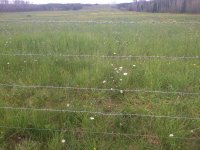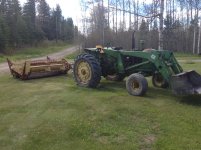You are using an out of date browser. It may not display this or other websites correctly.
You should upgrade or use an alternative browser.
You should upgrade or use an alternative browser.
First Time Haying
- Thread starter Draagyn
- Start date
- Views: 6147
More options
Who Replied?
/ First Time Haying
#21
Draagyn
Silver Member
Thanks for the words biker! I picked up 2000lbs of 34-7-10-.2 today. Probably be spreading tomorrow if things go right!
rajela
New member
That should make something grow but you really need to spray the weeds so they don't use up all the N before the grass does. Weeds use twice a s much of everything to grow. They take up water, nutrients, and space. Check with the local feed stores and coops to see if they have a sprayer they rent or if they know some one that will come spray.
Draagyn
Silver Member
Fertilizer is on! Now for fencing, tractor tweaks, and working on hay equipment
wmonroe
Elite Member
How is it looking?
roadhunter
Elite Member
Awesome! Thanks guys I never would've known about the length of twine. I try to pick the local farmers brains, but they're hard to get ahold of. They never seem to be at home sitting on the couch...
Try the local café about 4:30 in the morning. That is where you find all the old farmers around my town.
Draagyn
Silver Member

 was looking great up to a couple weeks ago when the daisys and buttercups started to sprout up. I picked up a new holland 478 mower conditioner. Gonna grease and adjust everything up, weld the tire back on my tractor and try all my equipment out ahead of time. About a month left here until cutting time
was looking great up to a couple weeks ago when the daisys and buttercups started to sprout up. I picked up a new holland 478 mower conditioner. Gonna grease and adjust everything up, weld the tire back on my tractor and try all my equipment out ahead of time. About a month left here until cutting timeDraagyn
Silver Member
Also wondering if my grass base looks strong enough to do good if spraying for weeds with something like grazon?
Draagyn
Silver Member
Try the local café about 4:30 in the morning. That is where you find all the old farmers around my town.
Haha! Thanks for the tip! Now if only we had a Cafe. Maybe I'll have to start going to church...
Draagyn
Silver Member
PROFarms
Gold Member
- Joined
- Jun 19, 2012
- Messages
- 250
- Location
- Devon, England
- Tractor
- International 444, Yanmar YM169d, Cub Cadet
I should think that it will work ok just so long as you 'baby' it a bit especially when you get into thicker, heavier grass - thats where it could do damage and from experience it can do very expensive damage! Also i guess your field is fairly level and doesn't have many rocks in - again if you have rocks from experience you should be careful with a sickle as unlike a disc the sickle mower will break a LOT easier - personally we threw our old sickle in the hedge as soon as we tried out a discbine - they are amazing compared to a sickle. We still use a small sickle on my little 19hp yanmar and use that to cut hay in smaller fields.Been going over my new mower. The sickle has a pretty good bend in it. The guy I bought it off said he ran it last year with no problems but didn't mention the bend. I'm guessing it will work okay. What do you guys think? Here's a picView attachment 381148
Best of luck in your first haying season - hope the equipment holds up!!
Texasmark
Elite Member
- Joined
- Apr 24, 2012
- Messages
- 3,761
- Location
- N. Texas
- Tractor
- Ford: '88 3910 Series II, '80 3600, '65 3000; '07 6530C Branson with FEL, 2020 LS MT225S. Case-IH 395 and 895 with cab. All Diesels
On weeds, my cows loved butter cups and some other selective weeds.
I used Grazon P+D one year. The P was for brush and the D was 2-4-D, a popular broad leaf herbicide. I don't have any brush any longer and quit renewing my applicator license so I can't buy it. But I do go to the local farm store and buy D in quart bottles (not restricted) and mix at 1% (1 gallon in my 100 gal tank). D is a broadleaf herbicide and that's what you want for weeds in a grass patch.
I like D as it works the year you put it out and keeps working. On completely eliminating weeds, unless you spray often forget it. I have a field I have worked with a crop for over 30 years and every spring here they come. I notice it mostly when I have plowed the field. I guess plowing brings them up to the top where they can germinate.
On getting cleaner cuts later on in the year, a lot of people around here will want the second or third cutting for their hay as it usually has fewer weeds.
On fertilizing with chemicals, it depends on your soil and what was grown there as to what you need and what the plant you are growing needs. As stated by others, you should have an Ag. and Mech. (A&M) University somewhere around where you can send soil samples, tell them what you want to grow and how much and they will come back with what you have in your soil and what you will need to supplement it to grow what you said you wanted and how much of it. Ours has a www and a form to fill out, how to take the sample and how to ship. Real handy. Costs $10 per sample and they send you an email back in about a week with the answers. On my samples I go around the field and take several samples, mixing them together to get an averaging and send that in as one sample for $10.
I like to put my chem out about a week or so before I plant to give the plant a chance at getting it before the weeds take over. On grass, the popular grass here is Coastal Bermuda which is a long stemmed semi tropical grass, makes great horse hay (picky owners) which wouldn't be good for you but you can get on the www and find grasses that are perennial and suited for your area and your intended usage. For cows I plant annuals like the mess I am going through this year. Can't believe too good of a crop is a pain but this time it is.
Anyway, that grass is a warm season grass so I wait on the fert. till the temp gets up before fertilizing. I go out in the field and look for the new grass shoots for that season, telling me that the plants have started growing. Then fert.
Some N fert is urea and requires special attention to get it in the ground before it evaporates. Others are Ammonium Nitrate and Ammonium Sulfate. The sulfate is sulphur and some soils need that. It also is less % per wt but is less apt to give you grazing problems like the Nit. Too much Nit under adverse growing conditions could produce Nitrate Poisoning in cattle. Both are good to be absorbed into the soil without evaporating when broadcast like you would do over a grass field. Always best to fert right before a rain to prevent any evap loss but who can always be that lucky.
Oh, and chicken poop is the hottest of the available poops by a long shot.
These are a few things I learned from the school of hard knocks over the years.
HTH,
Mark
I used Grazon P+D one year. The P was for brush and the D was 2-4-D, a popular broad leaf herbicide. I don't have any brush any longer and quit renewing my applicator license so I can't buy it. But I do go to the local farm store and buy D in quart bottles (not restricted) and mix at 1% (1 gallon in my 100 gal tank). D is a broadleaf herbicide and that's what you want for weeds in a grass patch.
I like D as it works the year you put it out and keeps working. On completely eliminating weeds, unless you spray often forget it. I have a field I have worked with a crop for over 30 years and every spring here they come. I notice it mostly when I have plowed the field. I guess plowing brings them up to the top where they can germinate.
On getting cleaner cuts later on in the year, a lot of people around here will want the second or third cutting for their hay as it usually has fewer weeds.
On fertilizing with chemicals, it depends on your soil and what was grown there as to what you need and what the plant you are growing needs. As stated by others, you should have an Ag. and Mech. (A&M) University somewhere around where you can send soil samples, tell them what you want to grow and how much and they will come back with what you have in your soil and what you will need to supplement it to grow what you said you wanted and how much of it. Ours has a www and a form to fill out, how to take the sample and how to ship. Real handy. Costs $10 per sample and they send you an email back in about a week with the answers. On my samples I go around the field and take several samples, mixing them together to get an averaging and send that in as one sample for $10.
I like to put my chem out about a week or so before I plant to give the plant a chance at getting it before the weeds take over. On grass, the popular grass here is Coastal Bermuda which is a long stemmed semi tropical grass, makes great horse hay (picky owners) which wouldn't be good for you but you can get on the www and find grasses that are perennial and suited for your area and your intended usage. For cows I plant annuals like the mess I am going through this year. Can't believe too good of a crop is a pain but this time it is.
Anyway, that grass is a warm season grass so I wait on the fert. till the temp gets up before fertilizing. I go out in the field and look for the new grass shoots for that season, telling me that the plants have started growing. Then fert.
Some N fert is urea and requires special attention to get it in the ground before it evaporates. Others are Ammonium Nitrate and Ammonium Sulfate. The sulfate is sulphur and some soils need that. It also is less % per wt but is less apt to give you grazing problems like the Nit. Too much Nit under adverse growing conditions could produce Nitrate Poisoning in cattle. Both are good to be absorbed into the soil without evaporating when broadcast like you would do over a grass field. Always best to fert right before a rain to prevent any evap loss but who can always be that lucky.
Oh, and chicken poop is the hottest of the available poops by a long shot.
These are a few things I learned from the school of hard knocks over the years.
HTH,
Mark
Here are some similar links:
- Replies
- 117
- Views
- 8K
